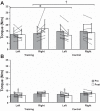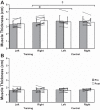Unilateral strength training leads to muscle-specific sparing effects during opposite homologous limb immobilization
- PMID: 29357520
- PMCID: PMC5972467
- DOI: 10.1152/japplphysiol.00971.2017
Unilateral strength training leads to muscle-specific sparing effects during opposite homologous limb immobilization
Abstract
Cross education (CE) occurs after unilateral training whereby performance of the untrained contralateral limb is enhanced. A few studies have shown that CE can preserve or "spare" strength and size of an opposite immobilized limb, but the specificity (i.e., trained homologous muscle and contraction type) of these effects is unknown. The purpose was to investigate specificity of CE "sparing" effects with immobilization. The nondominant forearm of 16 participants was immobilized with a cast, and participants were randomly assigned to a resistance training (eccentric wrist flexion, 3 times/week) or control group for 4 weeks. Pre- and posttesting involved wrist flexors and extensors eccentric, concentric and isometric maximal voluntary contractions (via dynamometer), muscle thickness (via ultrasound), and forearm muscle cross-sectional area (MCSA; via peripheral quantitative computed tomography). Only the training group showed strength preservation across all contractions in the wrist flexors of the immobilized limb (training: -2.4% vs. control: -21.6%; P = 0.04), and increased wrist flexors strength of the nonimmobilized limb (training: 30.8% vs. control: -7.4%; P = 0.04). Immobilized arm MCSA was preserved for the training group only (training: 1.3% vs. control: -2.3%; P = 0.01). Muscle thickness differed between groups for the immobilized (training: 2.8% vs. control: -3.2%; P = 0.01) and nonimmobilized wrist flexors (training: 7.1% vs. control: -3.7%; P = 0.02). Strength preservation was nonspecific to contraction type ( P = 0.69, [Formula: see text] = 0.03) yet specific to the trained flexors muscle. These findings suggest that eccentric training of the nonimmobilized limb can preserve size of the immobilized contralateral homologous muscle and strength across multiple contraction types. NEW & NOTEWORTHY Unilateral strength training preserves strength, muscle thickness, and muscle cross-sectional area in an opposite immobilized limb. The preservation of size and strength was confined to the trained homologous muscle group. However, strength was preserved across multiple contraction types.
Keywords: bilateral transfer; cross education; cross transfer; eccentric strength; muscle lengthening.
Figures



References
-
- Bodine SC, Stitt TN, Gonzalez M, Kline WO, Stover GL, Bauerlein R, Zlotchenko E, Scrimgeour A, Lawrence JC, Glass DJ, Yancopoulos GD. Akt/mTOR pathway is a crucial regulator of skeletal muscle hypertrophy and can prevent muscle atrophy in vivo. Nat Cell Biol 3: 1014–1019, 2001. doi: 10.1038/ncb1101-1014. - DOI - PubMed
-
- Buschbacher RM, Prahlow ND. Manual of nerve conduction studies. J Clin Neuromuscul Dis 2: 120, 2000. doi: 10.1097/00131402-200012000-00015. - DOI
Publication types
MeSH terms
Grants and funding
LinkOut - more resources
Full Text Sources
Other Literature Sources
Medical
Miscellaneous

